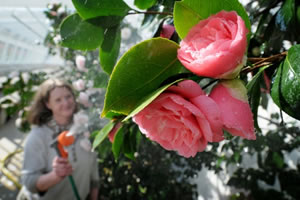‘Middlemist’s Red’ thought to be one of only two surviving examples in world
|
One of the world’s rarest camellias now has a fitting home thanks to major restoration works to the conservatory at Chiswick House, London.
‘Middlemist’s Red’, currently in bloom at the conservatory at Chiswick House, is thought to be one of only two surviving examples of this variety in the world and it would be a long trip to see the other one – it’s in Waitangi, New Zealand.
Meanwhile, the restoration of Chiswick’s 300 foot long conservatory, originally built in 1813 for the Sixth Duke of Devonshire, will soon be complete and will open to the public in June as the final piece in the renaissance of Chiswick House Gardens. The Trust and English Heritage have overseen the major repair programme as the conservatory was painstakingly dismantled and every piece of metal work recorded, before being accurately pieced back together.
‘Middlemist’s Red’ is believed to have been present in the Chiswick conservatory since the first half of the 19th century. Despite its name, the plant blooms a deep pink for around a month each year. The rare plant was originally brought to Britain from China in 1804 by Londoner John Middlemist, a nurseryman from Shepherd’s Bush. Middlemist gave the plant to Kew Gardens and a descendant of it made its way to Chiswick sometime after 1823, as the Sixth Duke added to his growing collection of camellias. The Chiswick camellias are world famous and believed to be the largest collection of the oldest known varieties in the Western world.
A magnificent hot-house
When the conservatory was completed in 1813, the author Mary Berry described it as “a magnificent hot-house” and it was a forerunner of those designed by Decimus Burton at Kew and Sir Joseph Paxton at Chatsworth. Despite an often turbulent history, the conservatory has housed camellias continuously since the early 19th century. The Devonshires rented out Chiswick House from the mid 1800s - at one point it served as a lunatic asylum - and the conservatory was neglected. It lost all its glass in the London bombings of the Second World War, and it even survived an unexploded bomb.
By the 1980s it had fallen into such disrepair that only the intervention of volunteers stopped the conservatory and the camellias being lost for ever. The current restoration has been overseen by the Chiswick House and Gardens Trust and English Heritage as part of an ongoing £12.1 million restoration project of the Gardens that will see them fully restored this summer.
Detailed archaeological and historical research was undertaken by English Heritage experts to ascertain the history of the conservatory and ensure the accuracy of the restoration.
Most 18th century conservatories housed fruits and were seen as exotic extensions of kitchen gardens, as a result most were built to look onto those gardens. The conservatory at Chiswick was unusual in that it looked onto a decorative Italian garden, which may be why the sixth Duke quickly turned it over to housing the exotic blooms that had started to make the voyage from the orient and were proving popular among the rich.
The restoration of the conservatory is almost complete. The public can enjoy the new conservatory from this summer and from next year will be able to admire ‘Middlemist’s Red’ and Chiswick’s other rare camellias in bloom in their beautifully restored setting.
March 10, 2010
